Annotated Bibliography: Sustainability Concepts, CUC100, Semester 1
VerifiedAdded on 2022/07/28
|7
|1063
|36
Annotated Bibliography
AI Summary
This annotated bibliography presents two key academic sources related to sustainability. The first source, by Herremans and Reid (2002), explores the sustainability triad and its application in educational settings, emphasizing the importance of developing environmental awareness among students. It highlights a case study to demonstrate the interplay between economic, social, and environmental dimensions. The second source, by Clune and Zehnder (2020), examines the evolution of sustainability models, focusing on the three-pillars framework (technology and innovation, laws and governance, and economics and financial incentives) as an effective approach for translating complex sustainability issues into actionable strategies. The annotated bibliography provides concise summaries and analyses of each source, highlighting their relevance to sustainability concepts, frameworks and practical applications.
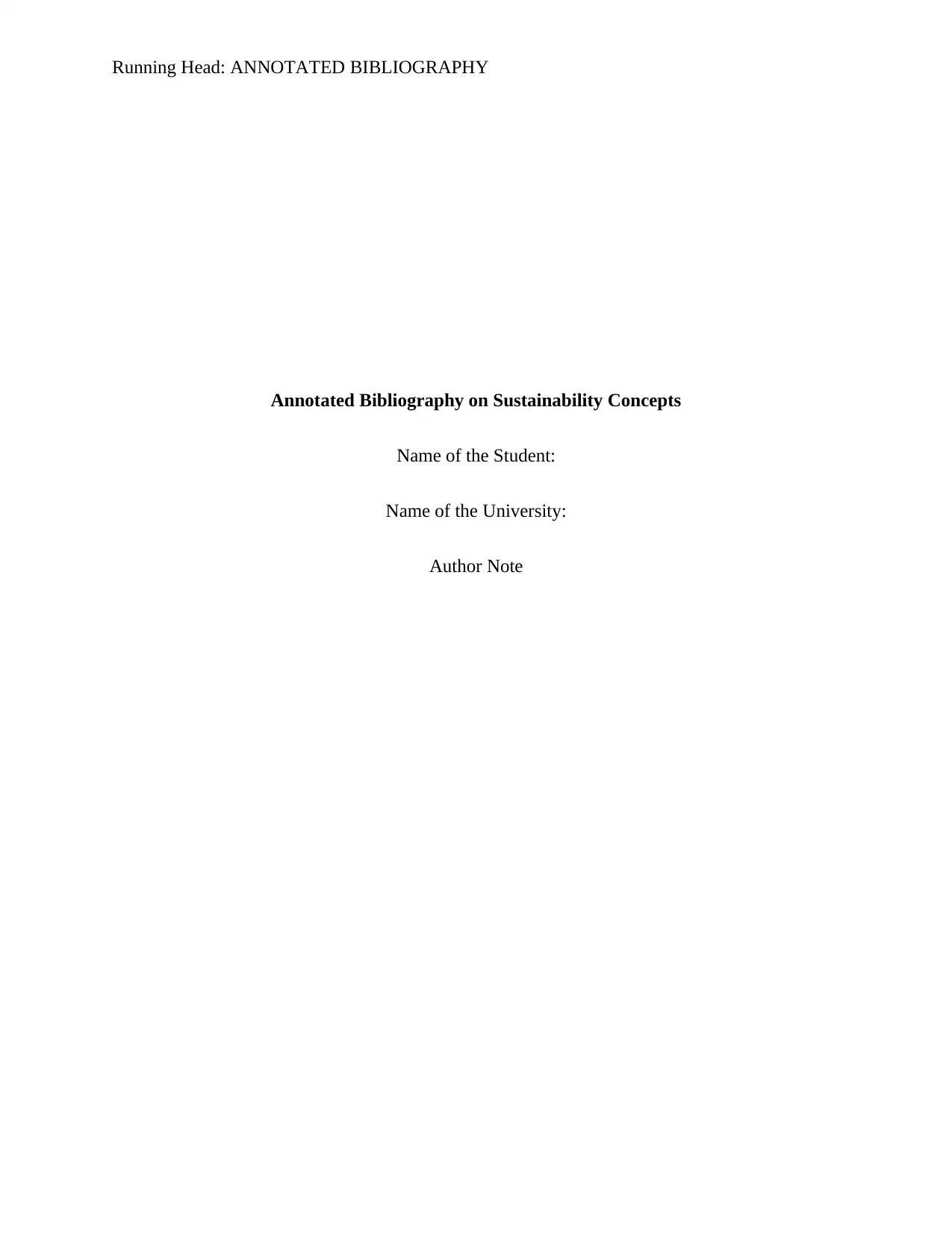
Running Head: ANNOTATED BIBLIOGRAPHY
Annotated Bibliography on Sustainability Concepts
Name of the Student:
Name of the University:
Author Note
Annotated Bibliography on Sustainability Concepts
Name of the Student:
Name of the University:
Author Note
Paraphrase This Document
Need a fresh take? Get an instant paraphrase of this document with our AI Paraphraser

1ANNOTATED BIBLIOGRAPHY
Herremans, I. M., & Reid, R. E. (2002). Developing awareness of the sustainability concept.
The Journal of Environmental Education, 34(1), 16-20.
The above mentioned source on the sustainability standard highlights the
responsibilities of the mainly the student fraternity to develop specific opportunities and
initiatives in order to become good environmental citizens not only in the role of
consumers but also as the providers of the environmentally feasible goods and services.
The reading has also highlighted the need to educate the students in order to help them to
take the decisions that will foster the growth of the environment along with the reflection
of the proper understanding levels towards the growth of sustainability. The reading has
highlighted the sustainability approach through the Waterton Minicase where it state that
the students should learn about the environmental issues through proper innovation and
discovery, second by developing proper attitudes and creating the values of sustainability
standards and finally an informed concern towards the development and growth of
personal ethics for environmental concern.
The reading has depicted the sustainability trial model through the three different
aspects of economic, environmental and social values. Here, the economic dimension
highlights the introduction, distribution and the consumption of the wealth which is
generally referred as the means of obtaining satisfaction of the material needs of people.
The social dimension pattern represents the mechanism of living or the association in
particular groups or communities that will consider the maintenance and the
improvement of the standards of the humans living.
Herremans, I. M., & Reid, R. E. (2002). Developing awareness of the sustainability concept.
The Journal of Environmental Education, 34(1), 16-20.
The above mentioned source on the sustainability standard highlights the
responsibilities of the mainly the student fraternity to develop specific opportunities and
initiatives in order to become good environmental citizens not only in the role of
consumers but also as the providers of the environmentally feasible goods and services.
The reading has also highlighted the need to educate the students in order to help them to
take the decisions that will foster the growth of the environment along with the reflection
of the proper understanding levels towards the growth of sustainability. The reading has
highlighted the sustainability approach through the Waterton Minicase where it state that
the students should learn about the environmental issues through proper innovation and
discovery, second by developing proper attitudes and creating the values of sustainability
standards and finally an informed concern towards the development and growth of
personal ethics for environmental concern.
The reading has depicted the sustainability trial model through the three different
aspects of economic, environmental and social values. Here, the economic dimension
highlights the introduction, distribution and the consumption of the wealth which is
generally referred as the means of obtaining satisfaction of the material needs of people.
The social dimension pattern represents the mechanism of living or the association in
particular groups or communities that will consider the maintenance and the
improvement of the standards of the humans living.
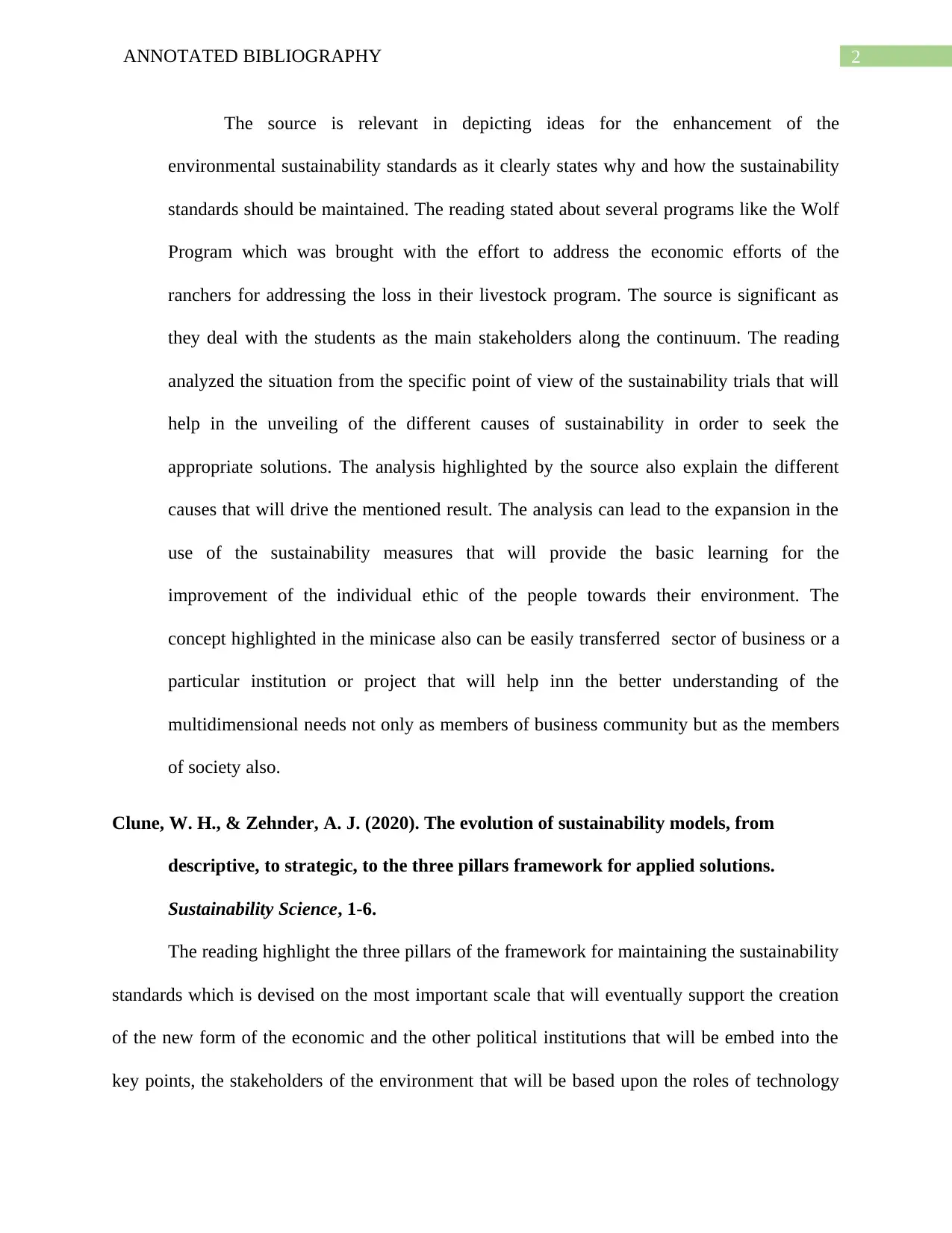
2ANNOTATED BIBLIOGRAPHY
The source is relevant in depicting ideas for the enhancement of the
environmental sustainability standards as it clearly states why and how the sustainability
standards should be maintained. The reading stated about several programs like the Wolf
Program which was brought with the effort to address the economic efforts of the
ranchers for addressing the loss in their livestock program. The source is significant as
they deal with the students as the main stakeholders along the continuum. The reading
analyzed the situation from the specific point of view of the sustainability trials that will
help in the unveiling of the different causes of sustainability in order to seek the
appropriate solutions. The analysis highlighted by the source also explain the different
causes that will drive the mentioned result. The analysis can lead to the expansion in the
use of the sustainability measures that will provide the basic learning for the
improvement of the individual ethic of the people towards their environment. The
concept highlighted in the minicase also can be easily transferred sector of business or a
particular institution or project that will help inn the better understanding of the
multidimensional needs not only as members of business community but as the members
of society also.
Clune, W. H., & Zehnder, A. J. (2020). The evolution of sustainability models, from
descriptive, to strategic, to the three pillars framework for applied solutions.
Sustainability Science, 1-6.
The reading highlight the three pillars of the framework for maintaining the sustainability
standards which is devised on the most important scale that will eventually support the creation
of the new form of the economic and the other political institutions that will be embed into the
key points, the stakeholders of the environment that will be based upon the roles of technology
The source is relevant in depicting ideas for the enhancement of the
environmental sustainability standards as it clearly states why and how the sustainability
standards should be maintained. The reading stated about several programs like the Wolf
Program which was brought with the effort to address the economic efforts of the
ranchers for addressing the loss in their livestock program. The source is significant as
they deal with the students as the main stakeholders along the continuum. The reading
analyzed the situation from the specific point of view of the sustainability trials that will
help in the unveiling of the different causes of sustainability in order to seek the
appropriate solutions. The analysis highlighted by the source also explain the different
causes that will drive the mentioned result. The analysis can lead to the expansion in the
use of the sustainability measures that will provide the basic learning for the
improvement of the individual ethic of the people towards their environment. The
concept highlighted in the minicase also can be easily transferred sector of business or a
particular institution or project that will help inn the better understanding of the
multidimensional needs not only as members of business community but as the members
of society also.
Clune, W. H., & Zehnder, A. J. (2020). The evolution of sustainability models, from
descriptive, to strategic, to the three pillars framework for applied solutions.
Sustainability Science, 1-6.
The reading highlight the three pillars of the framework for maintaining the sustainability
standards which is devised on the most important scale that will eventually support the creation
of the new form of the economic and the other political institutions that will be embed into the
key points, the stakeholders of the environment that will be based upon the roles of technology
⊘ This is a preview!⊘
Do you want full access?
Subscribe today to unlock all pages.

Trusted by 1+ million students worldwide
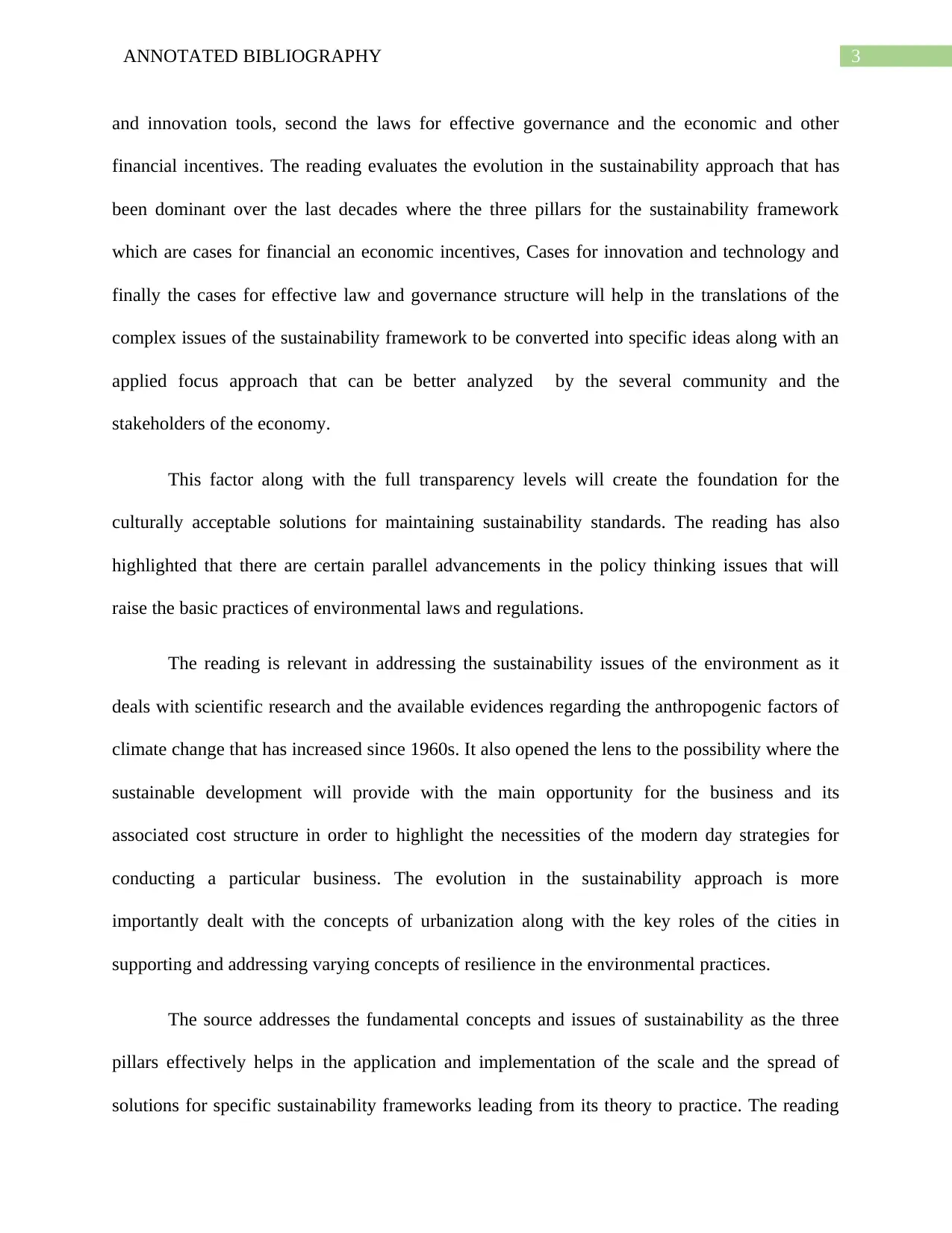
3ANNOTATED BIBLIOGRAPHY
and innovation tools, second the laws for effective governance and the economic and other
financial incentives. The reading evaluates the evolution in the sustainability approach that has
been dominant over the last decades where the three pillars for the sustainability framework
which are cases for financial an economic incentives, Cases for innovation and technology and
finally the cases for effective law and governance structure will help in the translations of the
complex issues of the sustainability framework to be converted into specific ideas along with an
applied focus approach that can be better analyzed by the several community and the
stakeholders of the economy.
This factor along with the full transparency levels will create the foundation for the
culturally acceptable solutions for maintaining sustainability standards. The reading has also
highlighted that there are certain parallel advancements in the policy thinking issues that will
raise the basic practices of environmental laws and regulations.
The reading is relevant in addressing the sustainability issues of the environment as it
deals with scientific research and the available evidences regarding the anthropogenic factors of
climate change that has increased since 1960s. It also opened the lens to the possibility where the
sustainable development will provide with the main opportunity for the business and its
associated cost structure in order to highlight the necessities of the modern day strategies for
conducting a particular business. The evolution in the sustainability approach is more
importantly dealt with the concepts of urbanization along with the key roles of the cities in
supporting and addressing varying concepts of resilience in the environmental practices.
The source addresses the fundamental concepts and issues of sustainability as the three
pillars effectively helps in the application and implementation of the scale and the spread of
solutions for specific sustainability frameworks leading from its theory to practice. The reading
and innovation tools, second the laws for effective governance and the economic and other
financial incentives. The reading evaluates the evolution in the sustainability approach that has
been dominant over the last decades where the three pillars for the sustainability framework
which are cases for financial an economic incentives, Cases for innovation and technology and
finally the cases for effective law and governance structure will help in the translations of the
complex issues of the sustainability framework to be converted into specific ideas along with an
applied focus approach that can be better analyzed by the several community and the
stakeholders of the economy.
This factor along with the full transparency levels will create the foundation for the
culturally acceptable solutions for maintaining sustainability standards. The reading has also
highlighted that there are certain parallel advancements in the policy thinking issues that will
raise the basic practices of environmental laws and regulations.
The reading is relevant in addressing the sustainability issues of the environment as it
deals with scientific research and the available evidences regarding the anthropogenic factors of
climate change that has increased since 1960s. It also opened the lens to the possibility where the
sustainable development will provide with the main opportunity for the business and its
associated cost structure in order to highlight the necessities of the modern day strategies for
conducting a particular business. The evolution in the sustainability approach is more
importantly dealt with the concepts of urbanization along with the key roles of the cities in
supporting and addressing varying concepts of resilience in the environmental practices.
The source addresses the fundamental concepts and issues of sustainability as the three
pillars effectively helps in the application and implementation of the scale and the spread of
solutions for specific sustainability frameworks leading from its theory to practice. The reading
Paraphrase This Document
Need a fresh take? Get an instant paraphrase of this document with our AI Paraphraser
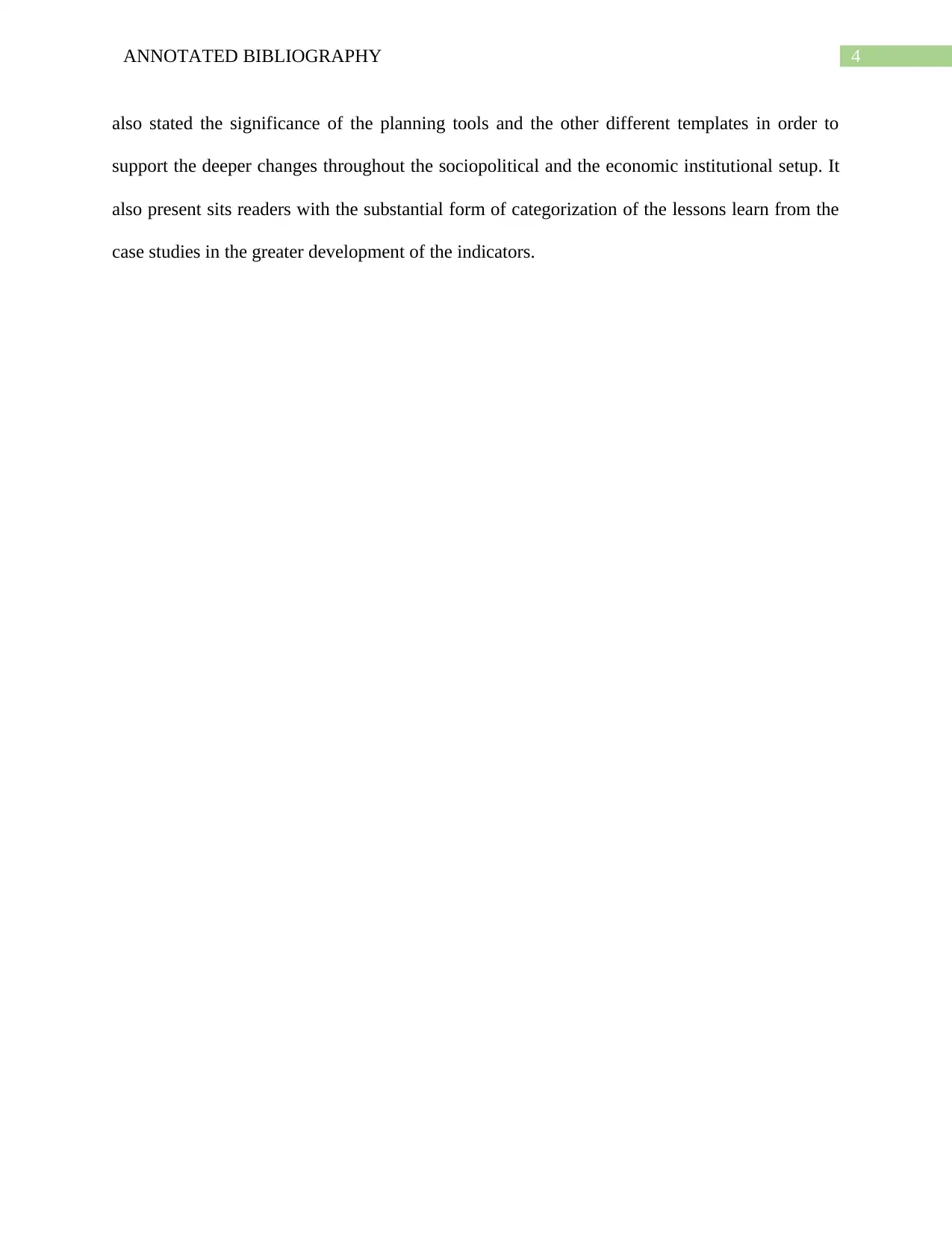
4ANNOTATED BIBLIOGRAPHY
also stated the significance of the planning tools and the other different templates in order to
support the deeper changes throughout the sociopolitical and the economic institutional setup. It
also present sits readers with the substantial form of categorization of the lessons learn from the
case studies in the greater development of the indicators.
also stated the significance of the planning tools and the other different templates in order to
support the deeper changes throughout the sociopolitical and the economic institutional setup. It
also present sits readers with the substantial form of categorization of the lessons learn from the
case studies in the greater development of the indicators.

5ANNOTATED BIBLIOGRAPHY
References
Clune, W. H., & Zehnder, A. J. (2020). The evolution of sustainability models, from descriptive,
to strategic, to the three pillars framework for applied solutions. Sustainability Science, 1-
6.
Herremans, I. M., & Reid, R. E. (2002). Developing awareness of the sustainability concept. The
Journal of Environmental Education, 34(1), 16-20.
References
Clune, W. H., & Zehnder, A. J. (2020). The evolution of sustainability models, from descriptive,
to strategic, to the three pillars framework for applied solutions. Sustainability Science, 1-
6.
Herremans, I. M., & Reid, R. E. (2002). Developing awareness of the sustainability concept. The
Journal of Environmental Education, 34(1), 16-20.
⊘ This is a preview!⊘
Do you want full access?
Subscribe today to unlock all pages.

Trusted by 1+ million students worldwide
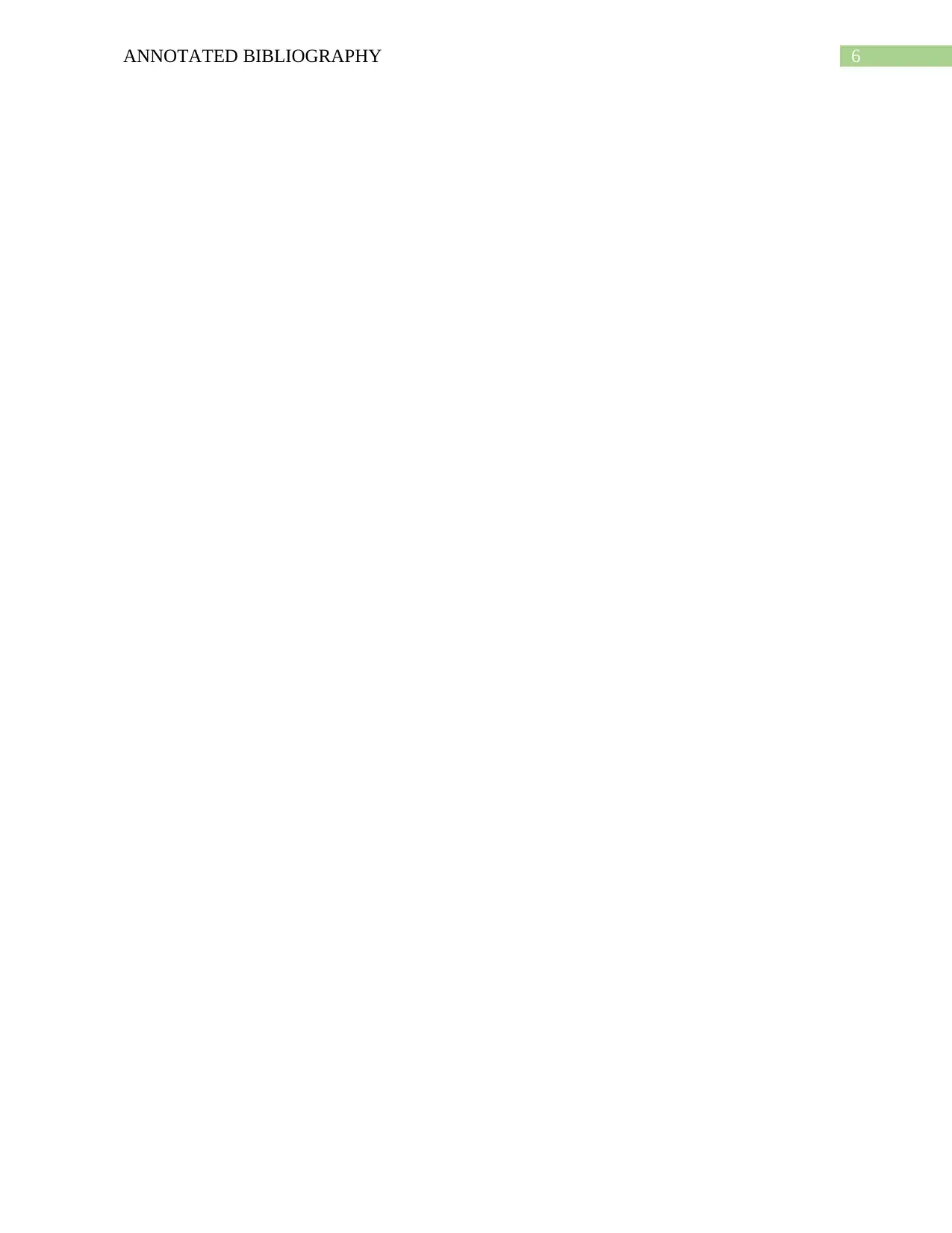
6ANNOTATED BIBLIOGRAPHY
1 out of 7
Related Documents
Your All-in-One AI-Powered Toolkit for Academic Success.
+13062052269
info@desklib.com
Available 24*7 on WhatsApp / Email
![[object Object]](/_next/static/media/star-bottom.7253800d.svg)
Unlock your academic potential
Copyright © 2020–2025 A2Z Services. All Rights Reserved. Developed and managed by ZUCOL.




